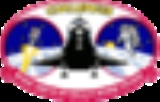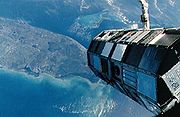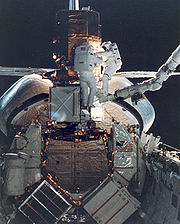
STS-41-C
Encyclopedia
STS-41-C was NASA
's 11th Space Shuttle
mission, and the fifth mission of Space Shuttle Challenger
. The launch on 6 April 1984 was the first direct ascent trajectory for a shuttle mission. STS-41-C was extended one day due to problems capturing the Solar Maximum Mission
("Solar Max") satellite, and the landing on 13 April took place at Edwards Air Force Base
, instead of at Kennedy Space Center
as had been planned.
Liftoff took place at 8:58 am EST on 6 April 1984. The mission marked the first direct ascent trajectory for the Space Shuttle, which reached its 288-nautical-mile-(533-km)-high orbit using its Orbiter Maneuvering System (OBS) engines only once, to circularize its orbit.


 The flight had two primary objectives. The first was to deploy the Long Duration Exposure Facility
The flight had two primary objectives. The first was to deploy the Long Duration Exposure Facility
(LDEF), a passive, retrievable, 21300 lbs, 12-sided cylinder, 14 feet (4.3 m) in diameter and 30 feet (9.1 m) long, carrying 57 scientific experiments. The second objective was to capture, repair and redeploy the malfunctioning Solar Maximum Mission
satellite – "Solar Max" – that had been launched in 1980.
The five-man crew included Robert L. Crippen, commander, on his third shuttle flight; pilot Francis R. Scobee; and mission specialists James D. A. van Hoften, Terry J. Hart and George D. Nelson.
On the second day of the flight, the LDEF was grappled by the "Canadarm" Remote Manipulator System (RMS) arm and successfully released into orbit. Its 57 experiments, mounted in 86 removable trays, were contributed by 200 researchers from eight countries. Retrieval of the passive LDEF had been scheduled during 1985, but schedule delays and the Challenger disaster of 1986 postponed the return until 12 January 1990, when Columbia
retrieved LDEF on mission STS-32
.
On the third day of the mission, Challengers orbit was raised to about 300 nautical miles (555.6 km), and it maneuvered to within 200 feet (61 m) of Solar Max. Astronauts Nelson and van Hoften, wearing spacesuits, entered the payload bay. Nelson, using the Manned Maneuvering Unit (MMU)
, flew out to the satellite and attempted to grasp it with a special capture tool, called the Trunnion Pin Acquisition Device (TPAD). Three attempts to clamp the TPAD onto the satellite failed. The Solar Max began tumbling on multiple axes when Nelson attempted to grab it by hand, by a solar array, and the effort was called off.
During the night, the Solar Max POCC, at Goddard Space Flight Center
, Greenbelt, Maryland
, was able to establish control over the satellite by sending commands ordering the magnetic torque bars to stabilize the tumbling action. This was successful, and the Solar Max went into a slow, regular spin.
The next day, Crippen maneuvered Challenger back to Solar Max, and Hart was able to grapple the satellite with the RMS. They placed Solar Max on a special cradle in the payload bay using the RMS. They then began the repair operation, replacing the satellite's attitude control mechanism and the main electronics system of the coronagraph instrument. The ultimately successful repair effort took two separate spacewalks. Solar Max was deployed back into orbit the next day. After a 30-day checkout by the Goddard POCC, the satellite resumed full operation.
Other STS-41-C mission activities included a student experiment located in a middeck locker to determine how honeybees make honeycomb
cells in a microgravity environment. They did so successfully, just as on Earth.
Highlights of the mission, including the LDEF deployment and the Solar Max repair, were filmed using an IMAX
movie camera, and the results appeared in the IMAX movie The Dream is Alive
.
The 6-day, 23-hour, 40-minute, 7-second mission ended on 13 April 1984, at 5:38 am PST, when Challenger landed on Runway 17, at Edwards AFB, having completed 108 orbits over the course of STS-41-C. Challenger was returned to KSC on 18 April 1984.
. Each track is specially chosen, often by the astronauts' families, and usually has a special meaning to an individual member of the crew, or is applicable to their daily activities.
NASA
The National Aeronautics and Space Administration is the agency of the United States government that is responsible for the nation's civilian space program and for aeronautics and aerospace research...
's 11th Space Shuttle
Space Shuttle
The Space Shuttle was a manned orbital rocket and spacecraft system operated by NASA on 135 missions from 1981 to 2011. The system combined rocket launch, orbital spacecraft, and re-entry spaceplane with modular add-ons...
mission, and the fifth mission of Space Shuttle Challenger
Space Shuttle Challenger
Space Shuttle Challenger was NASA's second Space Shuttle orbiter to be put into service, Columbia having been the first. The shuttle was built by Rockwell International's Space Transportation Systems Division in Downey, California...
. The launch on 6 April 1984 was the first direct ascent trajectory for a shuttle mission. STS-41-C was extended one day due to problems capturing the Solar Maximum Mission
Solar Maximum Mission
The Solar Maximum Mission satellite was designed to investigate solar phenomenon, particularly solar flares. It was launched on February 14, 1980....
("Solar Max") satellite, and the landing on 13 April took place at Edwards Air Force Base
Edwards Air Force Base
Edwards Air Force Base is a United States Air Force base located on the border of Kern County, Los Angeles County, and San Bernardino County, California, in the Antelope Valley. It is southwest of the central business district of North Edwards, California and due east of Rosamond.It is named in...
, instead of at Kennedy Space Center
Kennedy Space Center
The John F. Kennedy Space Center is the NASA installation that has been the launch site for every United States human space flight since 1968. Although such flights are currently on hiatus, KSC continues to manage and operate unmanned rocket launch facilities for America's civilian space program...
as had been planned.
Crew
Mission parameters
- MassMassMass can be defined as a quantitive measure of the resistance an object has to change in its velocity.In physics, mass commonly refers to any of the following three properties of matter, which have been shown experimentally to be equivalent:...
:- Orbiter liftoff: 254254 lbs
- Orbiter landing: 196975 lbs
- Payload: 57279 lbs
- PerigeePerigeePerigee is the point at which an object makes its closest approach to the Earth.. Often the term is used in a broader sense to define the point in an orbit where the orbiting body is closest to the body it orbits. The opposite is the apogee, the farthest or highest point.The Greek prefix "peri"...
: 138 miles (222.1 km) - Apogee: 291 miles (468.3 km)
- InclinationInclinationInclination in general is the angle between a reference plane and another plane or axis of direction.-Orbits:The inclination is one of the six orbital parameters describing the shape and orientation of a celestial orbit...
: 28.5° - PeriodOrbital periodThe orbital period is the time taken for a given object to make one complete orbit about another object.When mentioned without further qualification in astronomy this refers to the sidereal period of an astronomical object, which is calculated with respect to the stars.There are several kinds of...
: 91.4 min
Spacewalks
- Nelson and van Hoften – EVA 1
- EVA 1 Start: 8 April 1984 – 14:18 UTC
- EVA 1 End: 8 April 1984 – 16:56 UTC
- Duration: 2 hours, 38 minutes
- Nelson and van Hoften – EVA 2
- EVA 2 Start: 11 April 1984 – 08:58 UTC
- EVA 2 End: 11 April 1984 – 15:42 UTC
- Duration: 6 hours, 44 minutes
Mission summary
The flight was originally numbered STS-13.Liftoff took place at 8:58 am EST on 6 April 1984. The mission marked the first direct ascent trajectory for the Space Shuttle, which reached its 288-nautical-mile-(533-km)-high orbit using its Orbiter Maneuvering System (OBS) engines only once, to circularize its orbit.



Long Duration Exposure Facility
NASA's Long Duration Exposure Facility, or LDEF, was a school bus-sized cylindrical space experiment rack that exposed various material samples to outer space for about 5.7 years, completing 32,422 Earth orbits.- Construction :...
(LDEF), a passive, retrievable, 21300 lbs, 12-sided cylinder, 14 feet (4.3 m) in diameter and 30 feet (9.1 m) long, carrying 57 scientific experiments. The second objective was to capture, repair and redeploy the malfunctioning Solar Maximum Mission
Solar Maximum Mission
The Solar Maximum Mission satellite was designed to investigate solar phenomenon, particularly solar flares. It was launched on February 14, 1980....
satellite – "Solar Max" – that had been launched in 1980.
The five-man crew included Robert L. Crippen, commander, on his third shuttle flight; pilot Francis R. Scobee; and mission specialists James D. A. van Hoften, Terry J. Hart and George D. Nelson.
On the second day of the flight, the LDEF was grappled by the "Canadarm" Remote Manipulator System (RMS) arm and successfully released into orbit. Its 57 experiments, mounted in 86 removable trays, were contributed by 200 researchers from eight countries. Retrieval of the passive LDEF had been scheduled during 1985, but schedule delays and the Challenger disaster of 1986 postponed the return until 12 January 1990, when Columbia
Space Shuttle Columbia
Space Shuttle Columbia was the first spaceworthy Space Shuttle in NASA's orbital fleet. First launched on the STS-1 mission, the first of the Space Shuttle program, it completed 27 missions before being destroyed during re-entry on February 1, 2003 near the end of its 28th, STS-107. All seven crew...
retrieved LDEF on mission STS-32
STS-32
STS-32 was the 33rd mission of NASA's Space Shuttle program, and the 9th launch of Space Shuttle Columbia. Launching on 9 January 1990, it marked the first time since STS-61-C that Pad A at Kennedy Space Center's Complex 39 was used for a launch; it also marked the first use of Mobile Launcher...
.
On the third day of the mission, Challengers orbit was raised to about 300 nautical miles (555.6 km), and it maneuvered to within 200 feet (61 m) of Solar Max. Astronauts Nelson and van Hoften, wearing spacesuits, entered the payload bay. Nelson, using the Manned Maneuvering Unit (MMU)
Manned Maneuvering Unit
The Manned Maneuvering Unit is an astronaut propulsion unit which was used by NASA on three space shuttle missions in 1984. The MMU allowed the astronauts to perform untethered EVA spacewalks at a distance from the shuttle. The MMU was used in practice to retrieve a pair of faulty communications...
, flew out to the satellite and attempted to grasp it with a special capture tool, called the Trunnion Pin Acquisition Device (TPAD). Three attempts to clamp the TPAD onto the satellite failed. The Solar Max began tumbling on multiple axes when Nelson attempted to grab it by hand, by a solar array, and the effort was called off.
During the night, the Solar Max POCC, at Goddard Space Flight Center
Goddard Space Flight Center
The Goddard Space Flight Center is a major NASA space research laboratory established on May 1, 1959 as NASA's first space flight center. GSFC employs approximately 10,000 civil servants and contractors, and is located approximately northeast of Washington, D.C. in Greenbelt, Maryland, USA. GSFC,...
, Greenbelt, Maryland
Greenbelt, Maryland
Greenbelt is a city in Prince George's County, Maryland, United States. Contained within today's City of Greenbelt is the historic planned community now known locally as "Old Greenbelt" and designated as the Greenbelt Historic District...
, was able to establish control over the satellite by sending commands ordering the magnetic torque bars to stabilize the tumbling action. This was successful, and the Solar Max went into a slow, regular spin.
The next day, Crippen maneuvered Challenger back to Solar Max, and Hart was able to grapple the satellite with the RMS. They placed Solar Max on a special cradle in the payload bay using the RMS. They then began the repair operation, replacing the satellite's attitude control mechanism and the main electronics system of the coronagraph instrument. The ultimately successful repair effort took two separate spacewalks. Solar Max was deployed back into orbit the next day. After a 30-day checkout by the Goddard POCC, the satellite resumed full operation.
Other STS-41-C mission activities included a student experiment located in a middeck locker to determine how honeybees make honeycomb
Honeycomb
A honeycomb is a mass of hexagonal waxcells built by honey bees in their nests to contain their larvae and stores of honey and pollen.Beekeepers may remove the entire honeycomb to harvest honey...
cells in a microgravity environment. They did so successfully, just as on Earth.
Highlights of the mission, including the LDEF deployment and the Solar Max repair, were filmed using an IMAX
IMAX
IMAX is a motion picture film format and a set of proprietary cinema projection standards created by the Canadian company IMAX Corporation. IMAX has the capacity to record and display images of far greater size and resolution than conventional film systems...
movie camera, and the results appeared in the IMAX movie The Dream is Alive
The Dream Is Alive
The Dream is Alive is an IMAX movie, released in June 1985, about NASA's Space Shuttle program. The film was narrated by Walter Cronkite, and directed by Graeme Ferguson.-Synopsis:...
.
The 6-day, 23-hour, 40-minute, 7-second mission ended on 13 April 1984, at 5:38 am PST, when Challenger landed on Runway 17, at Edwards AFB, having completed 108 orbits over the course of STS-41-C. Challenger was returned to KSC on 18 April 1984.
Wake-up calls
NASA began a tradition of playing music to astronauts during the Gemini program, and first used music to wake up a flight crew during Apollo 15Apollo 15
Apollo 15 was the ninth manned mission in the American Apollo space program, the fourth to land on the Moon and the eighth successful manned mission. It was the first of what were termed "J missions", long duration stays on the Moon with a greater focus on science than had been possible on previous...
. Each track is specially chosen, often by the astronauts' families, and usually has a special meaning to an individual member of the crew, or is applicable to their daily activities.
| Flight Day | Song | Artist/Composer |
|---|---|---|
| Day 2 | "A Boy Named Sue A Boy Named Sue "A Boy Named Sue" is a song written by Shel Silverstein and performed by Johnny Cash. Cash was at the height of his popularity when he recorded the song live at California's San Quentin State Prison at a concert on 24 February 1969. The concert was filmed by Granada Television for later... " |
Johnny Cash Johnny Cash John R. "Johnny" Cash was an American singer-songwriter, actor, and author, who has been called one of the most influential musicians of the 20th century... |
| Day 3 | "Lehigh University Fight Song Lehigh University Lehigh University is a private, co-educational university located in Bethlehem, Pennsylvania, in the Lehigh Valley region of the United States. It was established in 1865 by Asa Packer as a four-year technical school, but has grown to include studies in a wide variety of disciplines... " |
|
| Day 4 | unidentified | |
| Day 5 | "Theme from Rocky Rocky Rocky is a 1976 American sports drama film directed by John G. Avildsen and both written by and starring Sylvester Stallone. It tells the rags to riches American Dream story of Rocky Balboa, an uneducated but kind-hearted debt collector for a loan shark in the city of Philadelphia, Pennsylvania... " |
|
| Day 6 | unidentified | |
| Day 7 | none | |
| Day 8 | "University of Texas Fight Song" |
See also
- Space explorationSpace explorationSpace exploration is the use of space technology to explore outer space. Physical exploration of space is conducted both by human spaceflights and by robotic spacecraft....
- Space Shuttle programSpace Shuttle programNASA's Space Shuttle program, officially called Space Transportation System , was the United States government's manned launch vehicle program from 1981 to 2011...
- List of space shuttle missions
- List of human spaceflights chronologically
External links
- NASA mission summary
- STS-41C Video Highlights
- The Dream is Alive IMAX film with footage from STS-41-C
- STS-41C NST Program Mission Report

